CULTURA. Venerdì 28 febbraio 2014 dalle 21.30 alle 23.30 EMPOLI – Ultimi appuntamenti da non…
Bernardo Rossellino, Baptismal Font, 1447
Bernardo Rossellino (Settignano 1409 – Firenze 1464)
Baptismal Font
made in 1447 – white marble; cm h 118 x 95 (vessel diameter) and cm 140 (basement diameter)
provenance: baptistery of San Giovanni nearby church Collegiata of S. Andrew (original location)
The baptismal font is located in its original place, that is the baptistery of San Giovanni, now becomed a part of Museum of St Andrew’s church in Empoli.
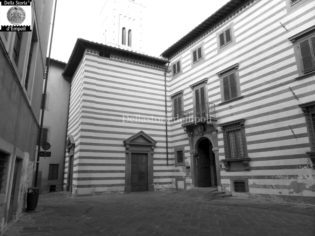
Origins and history
The sculpture is attributed to Bernardo Gamberelli, son’s Matteo, well-known as Bernardo Rossellino [1] (1409–1464).
It was commissioned in 1447 by family Giachini, probably by priest Antonio Giachini son of Giovanni [2], but it should not be mistaken about Giovanni Giachini son of Andrea also nicknamed as Malepa, as erroneously written by many authors;
He was appointed chaplain of baptistery of San Giovanni, so transformed into this new feature in 1464, while previously it was the church of San Giovanni Evangelista.
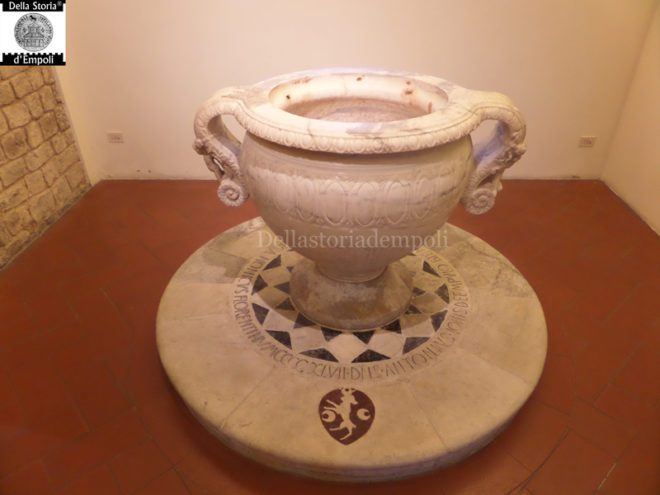
Description
The whole sculpture has been created so very refined, and it deserves to be ranked in the decorative plastic of Florentine Renaissance.
Shaped like a large two-handled amphora, entirely madeof white marble, and it’s resting on a circle shaped white marble platform.
The body of the vessel is carved by elegantly beans pattern turning roundly its surface.
The top edge is a circular ring embossed by a lot of ovules and arrows interspersed between them; it terminates to the sides on two minutely carved handles as if they had been manufactured by a goldsmith. These handles have been carved above by many overlapping scales, retired from nodes arranged serially as a human spine.
The handles culminate in two spirals evolving in festoons covered by fruits and lobed leaves, till wrapping around two cupids, respectively arranged one kneeling and one sitting on the spirals.
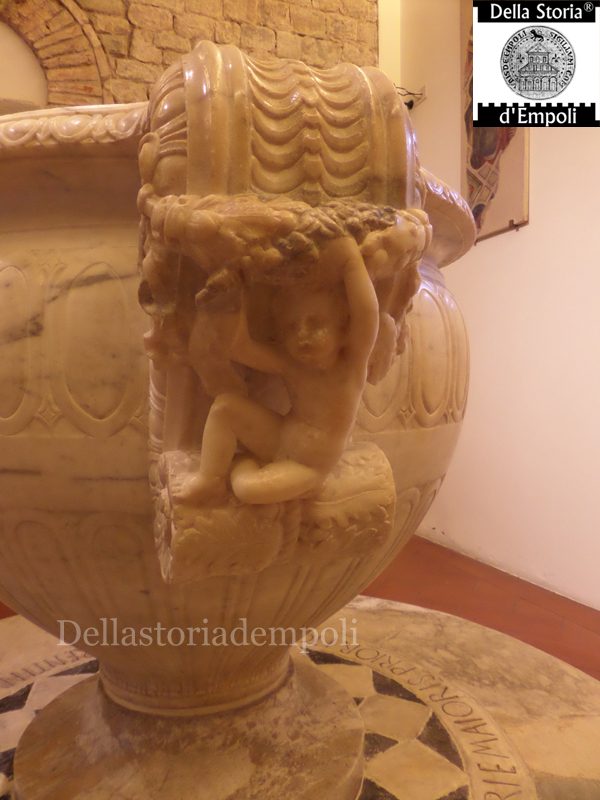
The ring inscription
The platform has a marble top surface and it made up of three distinct circular crowns: the outside is made up eleven white marble slabs shaped of concentric circular sectors and on one of them there’s a green marble carved representing the coat of arms of Giachini, the inner crown is made by white marble lozenges flanked and placed on a green marble background; in the middle crown there’s an inscription: it’s carved on a white marble background and over there’s a written that reads clockwise starting from Giachini’s coat of arms:
Strict transliteration
DNS · ANTONIUS · IOHIS · DEEMPVLO · BTE · MARIE MAIORIS · PRIOR · ETCA · NONICVS FLORENTINVMCCCCXLVII ·
correct reading
DNS · ANTONIUS · IOHIS · DEEMPVLO · BTE · MARIE MAIORIS · PRIOR · ET CANONICVS FLORENTINVM MCCCCXLVII ·
large text version
Dominus Antonius de Ioannes de Empulo Brevi Tempore Marie Maioris Prior et Canonicus Florentinum 1447
translated version
Mr Antonio son of Giovanni from Empoli already Prior of St Maria’s Maggiore church (in Florence, i.e.) and florentine priest.
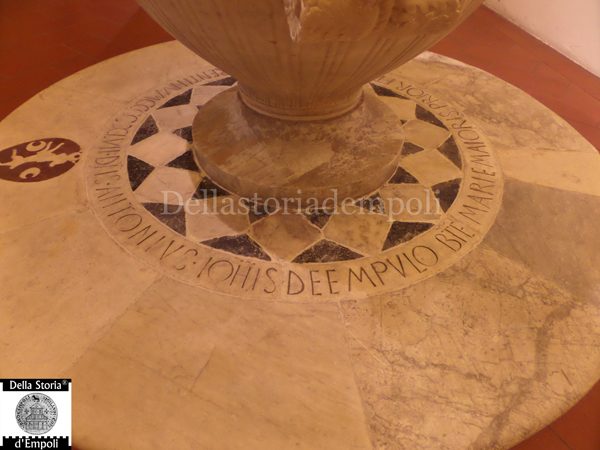
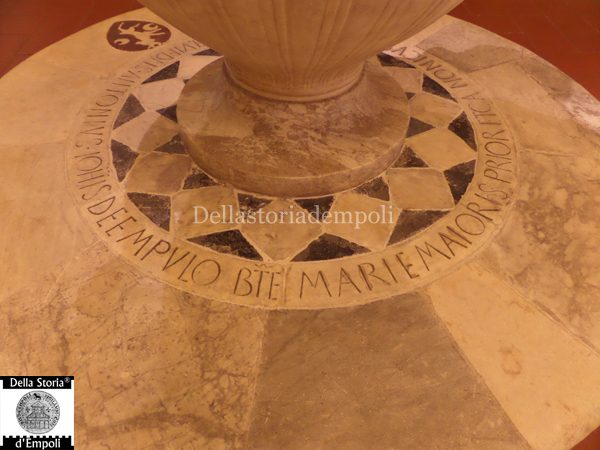
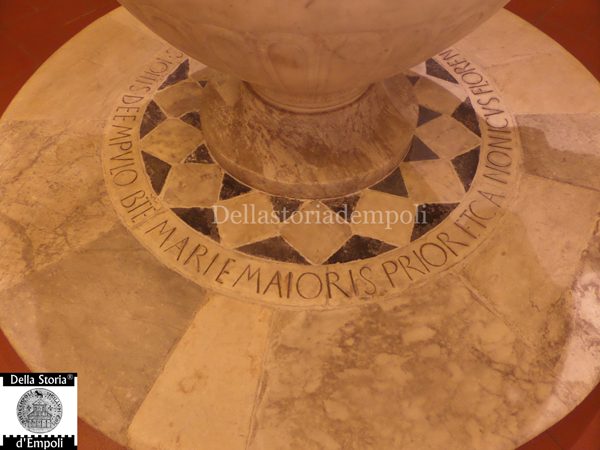
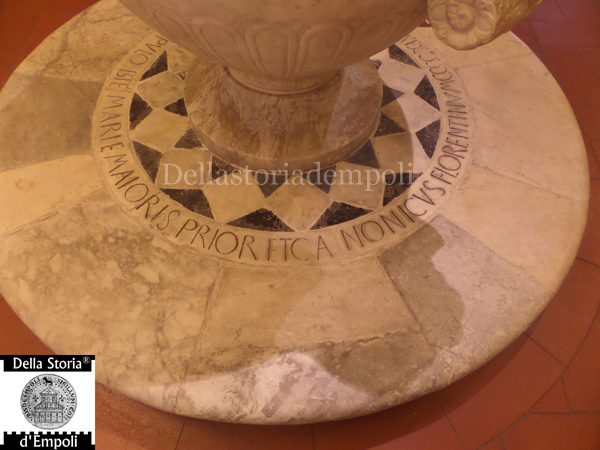
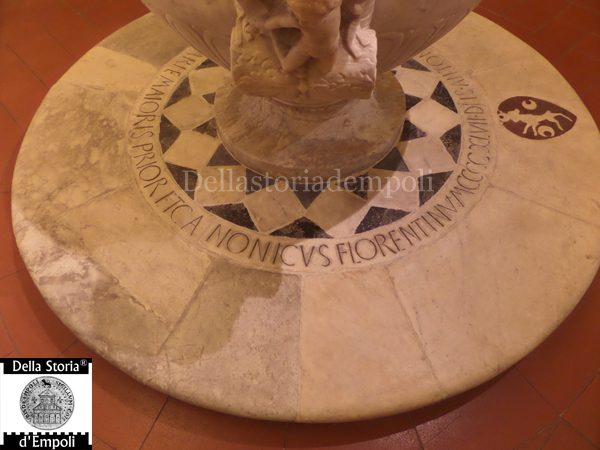
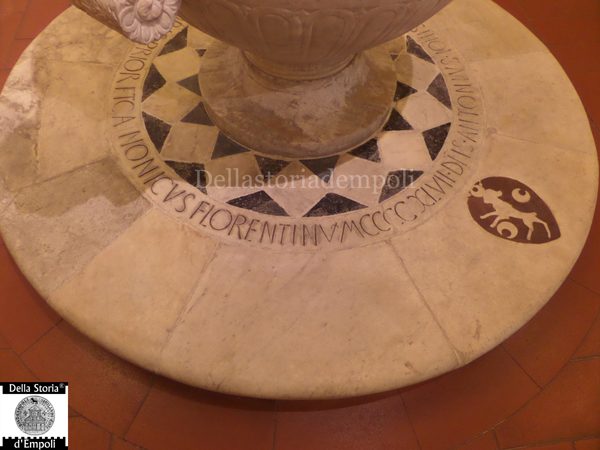
The attribution
Many experts have attributed the sculpture to different authors, nor I will list some in chronological order:
Eugene Müntz [3] wouldn’t overreach, but he admired the great beauty;
Jacob Burckhardt [4] in 1904 attributed to Pasquino from Montepulciano;
Odoardo H. Giglioli [5] in 1906 excluded the attribution to Donatello but he felt certain the attribution to his follower;
Antonio Paolucci [6] in 1985 formulated the attribution to Bernardo Rossellino recognizing his style marked by a «eloquent classicism»; he also considered the existence of a document dated August 2, 1447 [7], by whom the SS. Annuziata’s Company of nearby Santo Stefano’s church ordered to Rossellino two white marble sculptures (Virgin and the Angel), now located in the same church.
The same attribution is given by Rosanna Caterina Proto Pisani [8].
Coat of arms of Giachini
It’s made up green marble carved on the white marble platform outer ring.
The family came from Empoli, and became florentine citizenship in 1591; sometimes their surname is remembered or mentioned as «Giacchini» or «del Becco»[9]. This last surname should have been added as an extension to «Giachini» between 1604 and 1609 through some special deliberations.
Read the feature article →
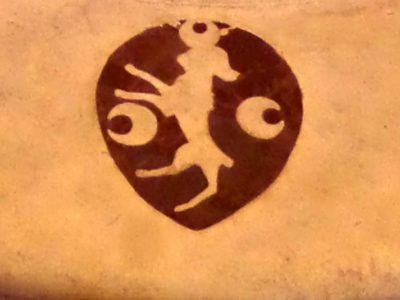
↖ Digital Guidebook of Museum of Sant’Andrea’s Collegiata of Empoli
↖ Index of EMPOLI ARTISTICA
Notes and references:
[1] Il museo della Collegiata di Sant’Andrea in Empoli, A. Paolucci, Firenze 1985, pag. 101;
[2] Sant’Andrea a Empoli, AA.VV., Cassa di Risparmio di Firenze 1994, pag 78;
[3] Il museo della Collegiata di Sant’Andrea in Empoli, Antonio Paolucci, Firenze 1985, pag. 100;
[4] Der Cicerone, Architektur – Skulptur – Malerei, Jacob Burckhardt , Verlag von E.A. Seemann, Leipzig 1904, pag 187;
[5] Empoli Artistica, Odoardo Hillyer Giglioli, Lumachi Editore, Firenze 1906, pag. 42;
[6] Il museo della Collegiata di Sant’Andrea in Empoli, A. Paolucci, Firenze 1985, pag. 101;
[7] Ibidem, pag. 98;
[8] Museo della Collegiata di Sant’Andrea a Empoli, R. C. Proto Pisani, collana “Piccoli Grandi Musei”, Firenze, Edizioni Polistampa, 2006, pag. 34;
[9] Archivio di Stato di Firenze, Fondo Ceramelli Papiani, Giachini, fascicolo 2329;
Reference bibliography
Empoli. Itinerari del Museo, della Collegiata e della Chiesa di Santo Stefano, R. C. Proto Pisani, collana “Biblioteca de Lo Studiolo”, Calenzano (Fi), Becocci/Scala, 2005;
Museo della Collegiata di Sant’Andrea a Empoli, R. C. Proto Pisani, collana “Piccoli Grandi Musei”, Firenze, Edizioni Polistampa, 2006;
Empoli, il Valdarno inferiore e la Valdelsa fiorentina, R. C. Proto Pisani, collana “I Luoghi della Fede”, Milano, Mondadori, 1999;
Empoli. I luoghi e tesori della storia, A. Naldi, P. Pianigiani, L. Terreni, Editori dell’Acero, Empoli 2012;
La Collegiata di Sant’Andrea a Empoli, la cultura romanica, la facciata, il restauro – Galletti, Moretti, Naldi, Edizioni dell’Erba, Fucecchio, 1991;
Chiese, cappelle, e oratori del territorio empolese, W.Siemoni, Editori dell’Acero, S. Croce sull’Arno, 1997;
Il museo della Collegiata di Sant’Andrea in Empoli, A. Paolucci, Firenze 1985;
Empoli, una città e il suo territorio, W. Siemoni e M. Frati, Editori dell’Acero, Santa Croce sull’Arno, 1997;
Empoli: città e territorio. Vedute e mappe dal ‘500 al ‘900, AA.VV., Editori dell’Acero, Santa Croce sull’Arno 1998;
Sant’Andrea a Empoli, AA.VV., Cassa di Risparmio di Firenze 1994;
Guida d’Empoli illustrata, Gennaro Bucchi, Tipografia domenicana, Firenze 1916;
Empoli Artistica, Odoardo Hillyer Giglioli, Lumachi Editore, Firenze 1906;
Comments (1)
Lascia un commento
Devi essere connesso per inviare un commento.
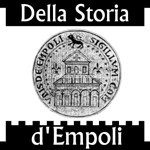
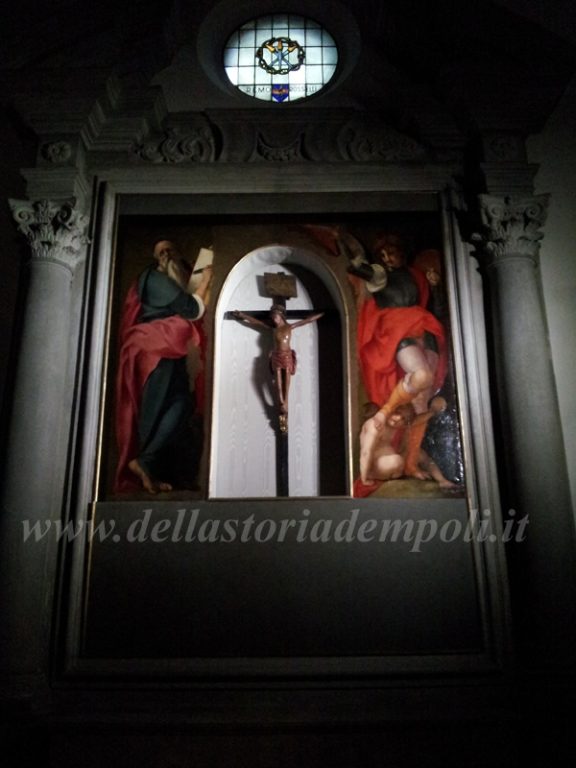
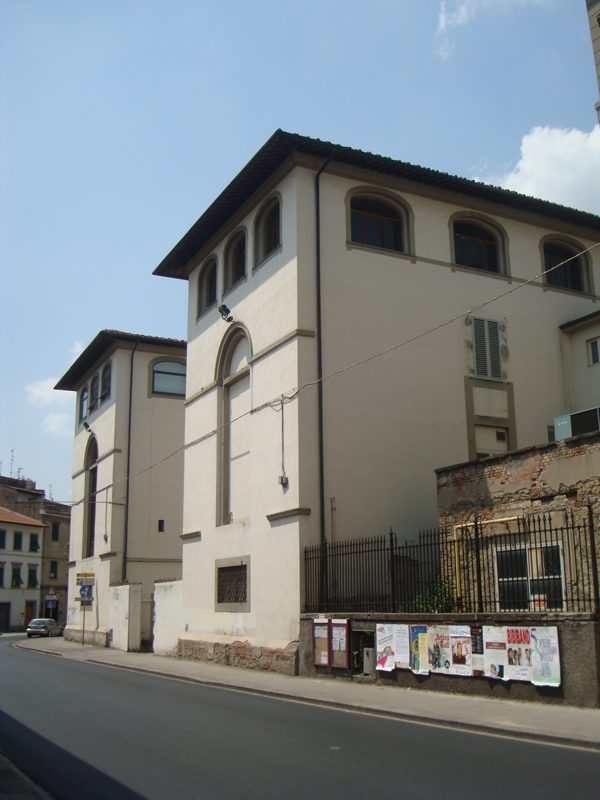
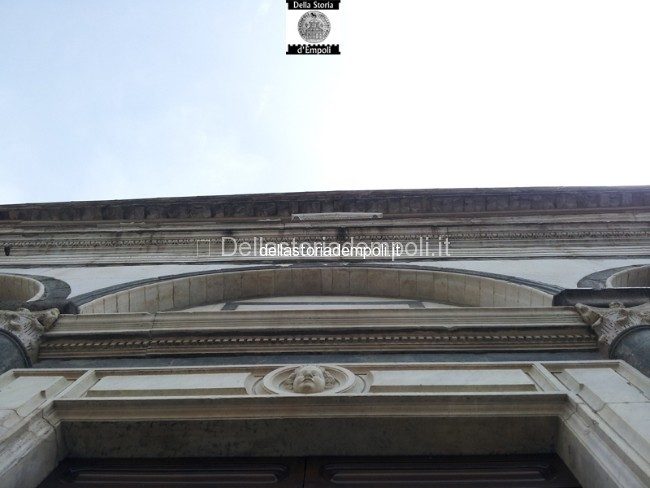
Grazie per aver creato questo blog